Well, we are trying to analyze the following circuit:

simulate this circuit – Schematic created using CircuitLab
When we use and apply KCL, we can write the following set of equations:
$$
\begin{cases}
\begin{alignat*}{1}
\text{I}_1&=\text{I}_2+\text{I}_5\\
\\
\text{I}_2&=\text{I}_3+\text{I}_4\\
\\
0&=\text{I}_0+\text{I}_4+\text{I}_5\\
\\
\text{I}_3&=\text{I}_0+\text{I}_1
\end{alignat*}
\end{cases}\tag1
$$
When we use and apply Ohm's law, we can write the following set of equations:
$$
\begin{cases}
\begin{alignat*}{1}
\text{I}_1&=\frac{\text{V}_\text{i}-\text{V}_1}{\text{R}_1}\\
\\
\text{I}_2&=\frac{\text{V}_1-\text{V}_2}{\text{R}_2}\\
\\
\text{I}_3&=\frac{\text{V}_2}{\text{R}_3}\\
\\
\text{I}_4&=\frac{\text{V}_2-\text{V}_3}{\text{R}_4}\\
\\
\text{I}_5&=\frac{\text{V}_1-\text{V}_3}{\text{R}_5}
\end{alignat*}
\end{cases}\tag2
$$
We also notice that \$\text{V}_3=\text{n}\cdot\text{V}_2\$.
Substitute \$(2)\$ into \$(1)\$, in order to get:
$$
\begin{cases}
\begin{alignat*}{1}
\frac{\text{V}_\text{i}-\text{V}_1}{\text{R}_1}&=\frac{\text{V}_1-\text{V}_2}{\text{R}_2}+\frac{\text{V}_1-\text{V}_3}{\text{R}_5}\\
\\
\frac{\text{V}_1-\text{V}_2}{\text{R}_2}&=\frac{\text{V}_2}{\text{R}_3}+\frac{\text{V}_2-\text{V}_3}{\text{R}_4}\\
\\
0&=\text{I}_0+\frac{\text{V}_2-\text{V}_3}{\text{R}_4}+\frac{\text{V}_1-\text{V}_3}{\text{R}_5}\\
\\
\frac{\text{V}_2}{\text{R}_3}&=\text{I}_0+\frac{\text{V}_\text{i}-\text{V}_1}{\text{R}_1}
\end{alignat*}
\end{cases}\tag3
$$
Now, we can solve the transfer function (with \$\text{R}_4\to\infty\$):
$$\mathcal{H}:=\frac{\text{V}_3}{\text{V}_\text{i}}=\frac{\text{n}\text{R}_3\text{R}_5}{\text{R}_1\left(\text{R}_2+\text{R}_5+\text{R}_3\left(1-\text{n}\right)\right)+\text{R}_5\left(\text{R}_2+\text{R}_3\right)}\tag4$$
Now, applying this to your circuit we need to use Laplace transform:
- $$\text{R}_3=\frac{1}{\text{sC}_1}\tag5$$
- $$\text{R}_5=\frac{1}{\text{sC}_2}\tag6$$
So, we get:
\begin{equation}
\begin{split}
\mathscr{H}\left(\text{s}\right)&=\frac{\displaystyle\text{n}\cdot\frac{1}{\text{sC}_1}\cdot\frac{1}{\text{sC}_2}}{\displaystyle\text{R}_1\left(\text{R}_2+\frac{1}{\text{sC}_2}+\frac{1}{\text{sC}_1}\cdot\left(1-\text{n}\right)\right)+\frac{1}{\text{sC}_2}\cdot\left(\text{R}_2+\frac{1}{\text{sC}_1}\right)}\\
\\
&=\frac{\text{n}}{\text{C}_1\text{C}_2\text{R}_1\text{R}_2\text{s}^2+\left(\text{C}_1\left(\text{R}_1+\text{R}_2\right)-\text{C}_2\text{R}_1\left(\text{n}-1\right)\right)\text{s}+1}
\end{split}\tag7
\end{equation}
Now, when we want to find the bode-plot of this filter we can take a look at the modulus of \$(7)\$ with \$\text{s}=\text{j}\omega\$:
\begin{equation}
\begin{split}
\left|\underline{\mathscr{H}}\left(\text{j}\omega\right)\right|&=\left|\frac{\text{n}}{\text{C}_1\text{C}_2\text{R}_1\text{R}_2\left(\text{j}\omega\right)^2+\left(\text{C}_1\left(\text{R}_1+\text{R}_2\right)-\text{C}_2\text{R}_1\left(\text{n}-1\right)\right)\text{j}\omega+1}\right|\\
\\
&=\frac{\left|\text{n}\right|}{\left|\text{C}_1\text{C}_2\text{R}_1\text{R}_2\left(\text{j}\omega\right)^2+\left(\text{C}_1\left(\text{R}_1+\text{R}_2\right)-\text{C}_2\text{R}_1\left(\text{n}-1\right)\right)\text{j}\omega+1\right|}\\
\\
&=\frac{\left|\text{n}\right|}{\left|1-\text{C}_1\text{C}_2\text{R}_1\text{R}_2\omega^2+\left(\text{C}_1\left(\text{R}_1+\text{R}_2\right)-\text{C}_2\text{R}_1\left(\text{n}-1\right)\right)\omega\text{j}\right|}\\
\\
&=\frac{\left|\text{n}\right|}{\sqrt{\left(1-\text{C}_1\text{C}_2\text{R}_1\text{R}_2\omega^2\right)^2+\left(\left(\text{C}_1\left(\text{R}_1+\text{R}_2\right)-\text{C}_2\text{R}_1\left(\text{n}-1\right)\right)\omega\right)^2}}
\end{split}\tag8
\end{equation}
And the argument is given by:
\begin{equation}
\begin{split}
\arg\left(\underline{\mathscr{H}}\left(\text{j}\omega\right)\right)&=\arg\left(\frac{\text{n}}{\text{C}_1\text{C}_2\text{R}_1\text{R}_2\left(\text{j}\omega\right)^2+\left(\text{C}_1\left(\text{R}_1+\text{R}_2\right)-\text{C}_2\text{R}_1\left(\text{n}-1\right)\right)\text{j}\omega+1}\right)\\
\\
&=\arg\left(\frac{\text{n}}{\underbrace{1-\text{C}_1\text{C}_2\text{R}_1\text{R}_2\omega^2}_{:=\space\alpha}+\underbrace{\left(\text{C}_1\left(\text{R}_1+\text{R}_2\right)-\text{C}_2\text{R}_1\left(\text{n}-1\right)\right)\omega}_{:=\space\beta}\cdot\text{j}}\right)\\
\\
&=\arg\left(\text{n}\right)-\arg\left(\alpha+\beta\text{j}\right)\\
\\
&=\begin{cases}0&\text{if}\space\text{n}\ge0\\\\\pi&\text{if}\space\text{n}<0\end{cases}-\begin{cases}
0&\text{if}\space\alpha\ge0\space\wedge\space\beta=0\\
\\
\pi&\text{if}\space\alpha<0\space\wedge\space\beta=0\\
\\
\arctan\left(\frac{\beta}{\alpha}\right)&\text{if}\space\alpha>0\space\wedge\space\beta>0\\
\\
\frac{\pi}{2}+\arctan\left(\frac{\left|\alpha\right|}{\beta}\right)&\text{if}\space\alpha<0\space\wedge\space\beta>0\\
\\
\frac{3\pi}{2}+\arctan\left(\frac{\alpha}{\left|\beta\right|}\right)&\text{if}\space\alpha>0\space\wedge\space\beta<0
\end{cases}
\end{split}\tag9
\end{equation}
Just for the sake of it, let's assume \$\text{R}_1=\text{R}_2:=\text{R}\$ and \$\text{C}_1=\text{C}_2:=\text{C}\$, than we find:
$$\left|\underline{\mathscr{H}}\left(\text{j}\omega\right)\right|=\frac{\left|\text{n}\right|}{\sqrt{\left(1-\left(\text{CR}\omega\right)^2\right)^2+\left(\text{CR}\omega\left(3-\text{n}\right)\right)^2}}\tag{10}$$
I used the following Mathematica-code, to solve for \$(7)\$:
In[1]:=Clear["Global`*"];
R3 = 1/(s*C1);
R5 = 1/(s*C2);
R4 = Infinity;
FullSimplify[(V3 /.
Solve[{I1 == I2 + I5, I2 == I2 == I3 + I4, 0 == I0 + I4 + I5,
I3 == I0 + I1, I1 == (Vi - V1)/R1, I2 == (V1 - V2)/R2,
I3 == V2/R3, I4 == (V2 - V3)/R4, I5 == (V1 - V3)/R5,
V3 == n*V2}, {I0, I1, I2, I3, I4, I5, V1, V2, V3}][[1]])/Vi]
Out[1]=n/(1 - C2 (-1 + n) R1 s + C1 s (R1 + R2 + C2 R1 R2 s))





